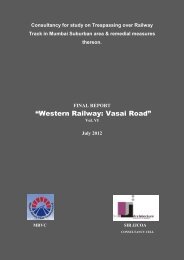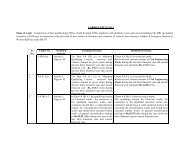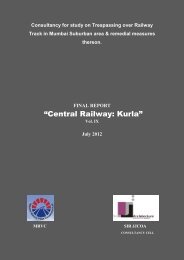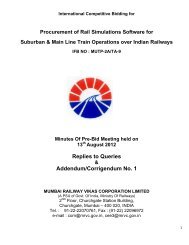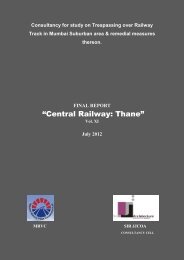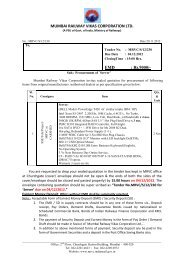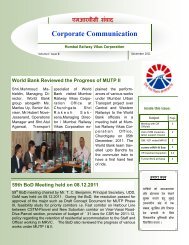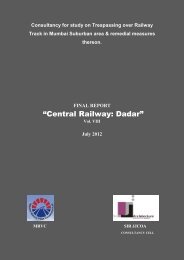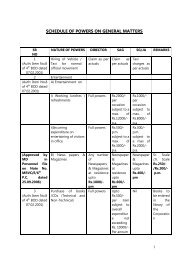World Bank Document - Mumbai Railway Vikas Corporation Ltd ...
World Bank Document - Mumbai Railway Vikas Corporation Ltd ...
World Bank Document - Mumbai Railway Vikas Corporation Ltd ...
You also want an ePaper? Increase the reach of your titles
YUMPU automatically turns print PDFs into web optimized ePapers that Google loves.
EMU trains are capable of 100 km/h under light traffic conditions, the actual average speed of<br />
the trains is a mere 35 km/h on most lines, the cumulative effect of several factors. 15<br />
78. Due to the overcrowding, doors of coaches cannot be closed and passengers dangle<br />
outside from the open doors. Nearby squatter settlements and encroachers within the railway<br />
right-of-way safety zone are other causes of frequent casualties on the <strong>Mumbai</strong> system. Stations<br />
are always overcrowded. People rarely use proper crossing places and prefer trespassing and<br />
crossing the rail lines. Trespassing, which occurs not only in the station areas but also in between<br />
them, forces trains to slow down and so increases travel times, limits capacity and hampers track<br />
maintenance work. Deaths of squatters and trespassers after being struck by a train and<br />
passengers falling off trains are a daily occurrence. There are about ten to twelve 16 deaths per<br />
day on the <strong>Mumbai</strong> rail system (which is high but still less than the rate of five to seven 17 deaths<br />
per day on the roads and streets in the MMR 18 , considering the far greater volumes carried by<br />
rail). Table 1 below shows the gravity of this issue: the numbers of deaths and injuries have<br />
grown at yearly rates of 3.3 and 5.6 percent respectively from 2001 to 2008, with an annual<br />
average growth of 4.4 percent for the total number of casualties. Among the causes of death and<br />
injury, the continued increase in the number of passengers falling off the train is particularly<br />
noteworthy (this increase is in part due to the increase in the number of trains and the opening of<br />
new lines). Reducing the number of fatalities related to its suburban rail services is one of the<br />
priorities of Western <strong>Railway</strong>, Central <strong>Railway</strong> and MRVC, which in November 2009 decided to<br />
prepare an action plan on how to effectively reduce the casualties among trespassers.<br />
Table 1. <strong>Railway</strong> Accidents in <strong>Mumbai</strong> Metropolitan Region, year by year<br />
2002 2003 2005 2006 2007 2008<br />
Accidental Deaths<br />
While crossing the railway line 1,971 2,517 2,479 2,561 2,603 2,448<br />
Falling off the train 603 453 494 606 647 615<br />
Others* 142 85 705 862 747 719<br />
Total Accidental Deaths 2,885 3,055 3,678 4,029 3,997 3,782<br />
Injured Persons<br />
While crossing the railway line 1,147 856 810 1,040 1,048 916<br />
Falling off the train 1,454 1,420 1,639 1,898 2,033 1,854<br />
Others 144 657 1,064 1,195 1,226 1,260<br />
Total Injured Persons 2,745 2,933 3,513 4,133 4,307 4,030<br />
Total Casualties 5,760 6,227 7,191 8,162 8,304 7,812<br />
Source: <strong>Mumbai</strong> <strong>Railway</strong> Police Commissionerate, 2007<br />
* Other causes of accidents include: falling off the platform, derailments, bridge collapses<br />
15 LEA Associates, Comprehensive Transportation Study.<br />
16 This amounts to 6.9 deaths per 100 million passenger-km (total suburban rail passenger traffic based on<br />
LEA Associates’ estimate is 173 million passenger-km/day in 2006).<br />
17 This amounts to 11.2 deaths per 100 million passenger-km (total road traffic including non-mechanized trips<br />
based on LEA Associates’ estimate is 62.5 million passenger-km/day in 2006).<br />
18 Basic Transport and Communication Statistics for MMR, March 2005, by MMRDA and Indian <strong>Railway</strong>s<br />
22





